|
home
definition
anatomy
airway evaluation
difficult airway algorithm
face mask
tracheal intubation
laryngeal mask

virtual library


|
|
esophageal-tracheal
Combitube
|
The esophageal-tracheal Combitube (ETC) is a
double-lumen, double-cuffed tube.
|
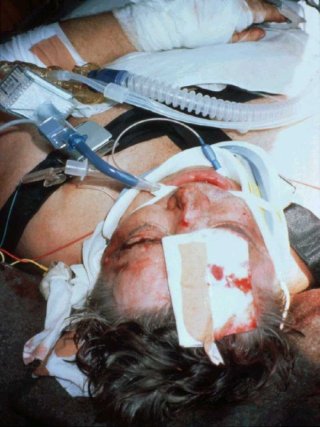 |
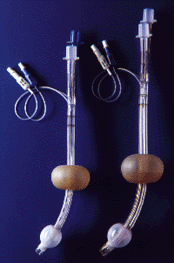 |
|
ETC was
invented by Prof. Michael Frass (Professor of
Medicine, Department of Internal Medicine, Intensive
Care Unit, University Hospital of Vienna). |
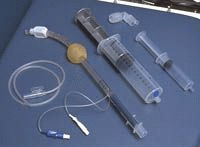 |
two sizes:
37 F
- small adult
41 F
- adult
|
back to top
|
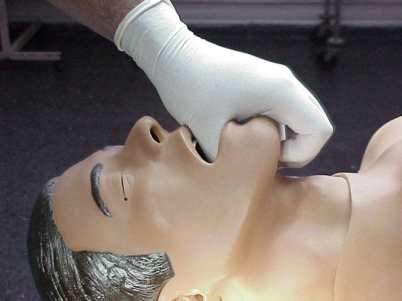 |
1
with the patient’s head in a neutral position,
the
lower jaw and tongue are lifted by one hand, the
tongue is pressed forwards
 during
insertion, the tongue should be pressed out of the
way with the help of the deeply inserted thumb during
insertion, the tongue should be pressed out of the
way with the help of the deeply inserted thumb |
|
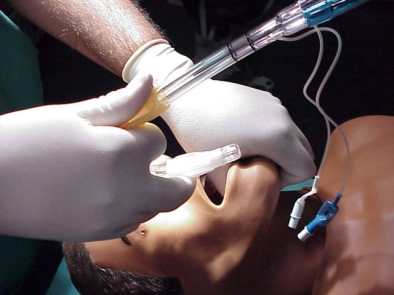 |
2
the
Urtubia maneuver is
always useful for blind insertion: the Combitube is
held bent between
the balloons for a few
seconds to facilitate insertion
|
|
 3 3
the tube is inserted
in a curved downward very “flat” movement
|
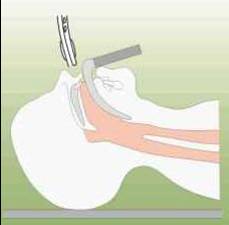 |
4
ETC
can be inserted orally either blindly or with a
laryngoscope |
|
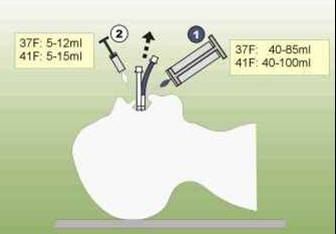 |
5
the tube is inserted until the printed ringmarks lie
between the teeth or alveolar ridges
6
first, the oropharyngeal balloon is inflated with 85
ml (Combitube 37 F) or 100 ml (41 F)
7
then, the distal balloon is inflated with 5 to 12 ml
(Combitube 37 F); 5 to 15 ml (41 F)
|
|
back to top
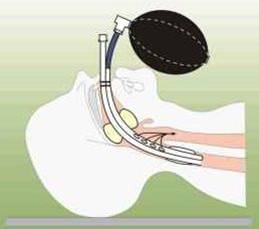 |
8
there is a high probability that
the tube will be placed in the esophagus
 test
ventilation is recommended via the longer blue tube No. 1 test
ventilation is recommended via the longer blue tube No. 1
 air
passes through the longer tube, leading to the esophageal
lumen, into the pharynx and from there over the epiglottis
into the trachea since mouth, nose and esophagus are blocked
by the balloons air
passes through the longer tube, leading to the esophageal
lumen, into the pharynx and from there over the epiglottis
into the trachea since mouth, nose and esophagus are blocked
by the balloons
 auscultation
of breath sounds in the absence of gastric insufflation
confirms adequate ventilation when the Combitube auscultation
of breath sounds in the absence of gastric insufflation
confirms adequate ventilation when the Combitube
is in the
esophagus
|
|
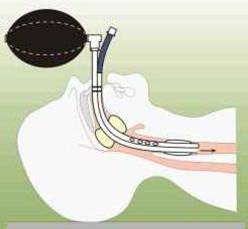
|
9
when no breath sounds are heard
over the lungs in the presence of gastric insufflation, the
Combitube has been placed into the trachea
 ventilation
is changed to the shorter clear tube No. 2, leading to the
tracheal lumen ventilation
is changed to the shorter clear tube No. 2, leading to the
tracheal lumen
 now,
air flows directly into the trachea now,
air flows directly into the trachea
|
|
|
 in
a few cases, ventilation does not work via
either lumen
in
a few cases, ventilation does not work via
either lumen
because the Combitube may have
been placed too deep
|
 move
the Combitube about 3 cm out of the patient’s
mouth
move
the Combitube about 3 cm out of the patient’s
mouth
and
try ventilation again via the esophageal lumen
|
ETC is
contraindicated in:
 patients
smaller than four feet, Combitube 37 F SA (= small adult)
may be used in patients between four and six feet patients
smaller than four feet, Combitube 37 F SA (= small adult)
may be used in patients between four and six feet
 intact
gag reflexes irrespective of their level of
consciousness intact
gag reflexes irrespective of their level of
consciousness
 known
esophageal pathology; patients who have ingested caustic
substance known
esophageal pathology; patients who have ingested caustic
substance
 obstruction
of the upper airways, e.g. foreign bodies, tumors, etc.. obstruction
of the upper airways, e.g. foreign bodies, tumors, etc..
back to top |

|
Esophageal-Traqueal
Combitube
Michael Frass |
|
|
|
Combitube
News: emergency medicine |
|
|
|
Current
Status of the Combitube: A
Review of the Literature
Felice Agro, Michael Frass,
Jonathan L. Benumof, Peter
Krafft
|
|
|
|
The
critical airway, rescue
ventilation, and the Combitube:
Part 1
James M. Rich, CRNA, Andrew M.
Mason, Tareg A. Bey, Peter
Krafft, Michael Frass
|
|
|
|
The
critical airway, rescue
ventilation, and the Combitube:
Part 2
James M. Rich, CRNA, Andrew M.
Mason, Tareg A. Bey, Peter
Krafft, Michael Frass |
|
|
|
|
|
|